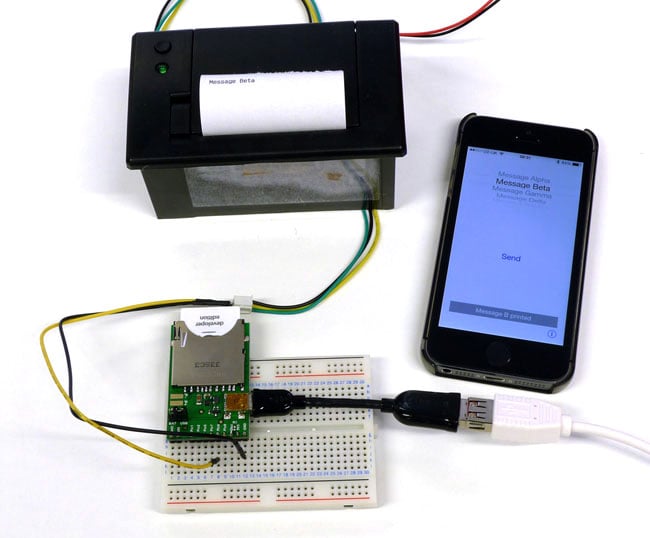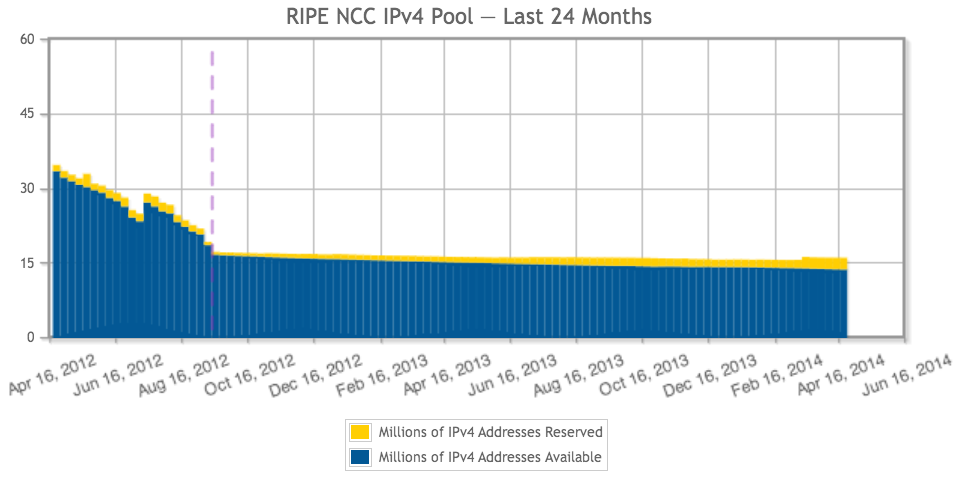Original URL: https://www.theregister.com/2014/04/24/ipv6_iot/
DeSENSORtised: Why the 'Internet of Things' will FAIL without IPv6
What's stopping a tinyputer invasion? An IP address shortage, says Cisco
Posted in Networks, 24th April 2014 09:04 GMT
Analysis For more than 20 years, it has been clear that the internet will eventually run out of public IPv4 addresses. Despite that limit, online businesses have been slow to adopt IPv6, which has an abundance of addresses by comparison.
Now that tech companies are eager to use the phrase "Internet of Things" (IoT) or the "Internet of Everything" (IoE), IPv6 lobbyists are keen to stress the dangers if the IT world does nothing about the looming address shortage.
IPv4, as you may know, uses a 32-bit system, giving it about 4.29 billion possible addresses for devices; in reality, when you take into account reserved and private spaces and other overheads, that figure can be no more than about 3.7 billion public addresses. Meanwhile, IPv6 uses 128 bits, which opens up a maximum of 340 undecillion addresses (that's 340 with 36 zeros after it), although really only about 42 undecillion are useful.
Sadly, switching from IPv4 to IPv6 isn't as trivial as you may think, even though modern operating systems and networking kit support both protocols: a device configured with a single IPv6 address cannot directly talk to a thing with an IPv4 address, and vice versa, so you can't just throw the two protocols into the mix without some sort of bridging.
But the move is not impossible, and supporters of IPv6 have dusted off their old forum, which had been dormant for some time thanks to the lack of appetite for the protocol, to promote its wide-open address space and other qualities.
The Internet of Things – a world of ultra-low-power embedded sensors, motors, and similar gadgets, all connected up like billions of tiny tentacles to data-crunching computers – seems, at present, a faddish marketing ploy by networking outfits that are keen to flog more kit.

Building the internet of things ... it may not look like much now, but networking giants think electronics born from development kit like this will take over the world
The likes of Cisco, which this year pumped $100m into IoT, see it differently, however. The corporation is convinced that 50 billion devices can be linked directly to the internet by 2020, even though adoption of IPv6 remains sluggish and IPv4 can't support that many publicly addressable things.
There's always NAT, of course, to keep IPv4 alive, but we're told that's rather 20th century: Cisco's UK and Ireland chief technology officer Ian Foddering, when quizzed by The Register, insisted that the success of IoT hinges on IPv6 being embraced quite swiftly. He told us:
Yes, within the existing IPv4 infrastructure you can do things such as network address translation (NAT), but in terms of scalability and sustainability and actually being able to support the capability we're talking about – some 50 billion devices by the year 2020 – that's going to be really difficult to do on a IPv4 environment.
I think the adoption of IPv6 will be key. The ability for the UK in particular to start to more heavily deploy it at a consumer level is also important.
Foddering added that in Blighty only a small number of internet service providers, including Virgin Media, were fully committed to enabling IPv6 capability. One-time national telco BT, on the other hand, continues to largely shrug off moving to the newer net addressing scheme.
"BT have IPv6 in its core," Foddering said. "BT also has a spare capacity of IPv4 addresses so the compelling reason for them to move at the moment probably isn't there."
He doesn't expect BT's attitude to change until those spare addresses start to deplete.
Cisco's CTO added that, while a lot of technology supports IPv6, some private and public sector organisations were struggling to understand the implications of not moving quickly to that protocol.
Education is key, Foddering said. He added that Cisco was among the companies attempting to "reignite the interest and awareness around IPv6", but admitted that training programmes and tech skills were "sparse at the moment":
Part of the inertia has come from 'what has been the compelling reason up to now'. We're rapidly seeing more and more laptops and tablets and smartphones being connected, but increasingly we're seeing these sensors and these other things being connected to the network, and that's driving the demand. I think the compelling reason is there now in terms of IoE and I would fully expect a much greater adoption going forward.
Specifically with IoT, or IoE as Cisco prefers to brand it, Foddering said security issues remained a barrier to plugging many more devices into the 'net – after all, defending 50 billion devices from data thieves and other miscreants could well be the biggest challenge facing the IT security industry, if not the wider world if it really takes off.
But he said younger people were comfortable with sharing information and connecting things together, so security worries are unlikely to slow down complacent youngsters in seizing IoT gadgets.
When asked if the British government had any concerns about IPv6 adoption, however, el Reg got the sense that it is a topic way down on the list of subjects that Whitehall pays much interest to.
"There is an acceptance that this is something that needs to be tackled," Foddering, who regularly talks to culture minister Ed Vaizey, said.
"It's certainly on the agenda, but just one of many, many different aspects that needs to be contended with."
The Cisco man is hoping that the return of the IPv6 forum "will add some value in terms of acting as a bit of a political vehicle for the question to be raised and answered into government." He added: "IoE presents a fantastic opportunity to allow that to happen."
Ripe for the taking: Exactly how many addresses are left?
Axel Pawlik, the managing director of IP address allocation registry RIPE Network Coordination Centre, told us that, especially in light of the big marketing play from some tech outfits with IoT, "the sluggish adoption rate of IPv6 is going to be a problem if that doesn't change."
According to RIPE NCC, there were, as of 21 April, 13.77m IPv4 public addresses left for the regions it manages: Europe, the Middle East and parts of Central Asia. Its US counterpart ARIN (the American Registry for Internet Numbers) – which covers Canada, the United States, and many Caribbean and North Atlantic islands – is now down to its last 16 million or so.

Available public IPv4 addresses from RIPE NCC stats ... Yellow addresses are reserved in quarantine, blue are available for use (click to enlarge)
It's not a completely doomed picture, however. According to figures last year from web content distribution network Akamai, a number of European countries, along with the US and Japan, were at the forefront of IPv6 adoption.
We asked Pawlik to explain why it is he believes that the widespread take-up of IPv6 was still being resisted by some businesses.
"Unfortunately it's a little bit late," he warned. "We thought the world would act in a grown up way, but well..."
This shows the source of requests to Akamai web servers
using IPv6 during a 24-hour period in May 2013.
Significantly, the UK – as this table demonstrates – is way behind.
Middle management types at larger corporations were particularly weary of rushing to IPv6, said Pawlick. He added that bigger companies were "not as flexible" on the protocol.
He was alarmed by our recent story that showed BT responding slowly to the fact that the IPv6 SSL certificate on its consumer website remained expired for about three weeks before the telecoms giant fixed the embarrassing cock-up.
"I am very disappointed in BT," he said, adding:
It's the big corporate structure that, I believe, is just too slow to get official projects through the ranks and being approved, risk assessment and all that type of thing. That's where we see the pain.
Pawlik added smaller companies were "always very flexible and very forward-oriented so, of course, they do IPv6 and there's nothing wrong with that. But until that filters through to the mother companies, it's a case of too many people to convince, too many committees."
The RIPE NCC boss agreed that the attitude appears to be "if it ain't broke, don't fix it". He said that, for IoT to be successful, it needs a protocol that allocate billions and billions of IP addresses to countless devices:
Certainly you can work with IPv4 addresses and stack them on top of each other and network address allocation ... and you can multiplex them, all those complex engineering solutions and they seem to work for a while, but all the experts say 'yeah, go build on that', and at some point it's too complicated, it will collapse and the functionality will go away and then of course you have all the very disappointed customers who say 'oh, I bought my lightbulb but now I can't switch it on and off anymore because I can't reach it on the internet.' the obvious way out is IPv6 and more addresses.
Can IoT gimmicks enthuse UK businesses enough to shift over to the internet addressing scheme? Probably not. After all, workarounds using IPv4 are still largely in play. Networks might get clunkier in the meantime. But IoT is hardly the killer marketing ploy to drag us kicking and screaming into the future. Unless, that is, yet-to-actually-be-purposefully-connected fridges or fitness bands that give you sweat rashes and monitor your heart beat are your thing.
The Register was naturally keen to seek the views of BT for this article. We were hoping to speak to the telco's Tim Rooney, who heads up IP address management at BT. The company, however, declined to offer up any comment beyond its previous statement to us in March this year when it said BT was "fully committed to IPv6 and has exciting plans for IPv6 in 2014."
Funny that. ®